‘Nashville’ Category
» posted on Tuesday, April 23rd, 2013 by Linda Lou Burton
Ghosts On The Hill
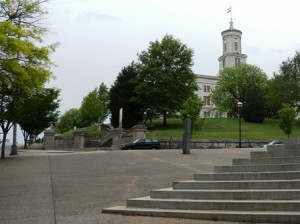 Linda Burton posting from Nashville, Tennessee – The couple behind was panting even more than me. There was a steep hillclimb to get to the capitol entry point and the closest parking was blocks away in an expensive high-rise garage. I passed THP scrutiny and received my entry pass but needed to catch my breath; I watched as the Tennessee Highway Patrol guard at the tunnel door went through his routine again. He opened the woman’s bag and searched it; he photocopied their photo ID and entered their names into his database. Finally issued passes,
Linda Burton posting from Nashville, Tennessee – The couple behind was panting even more than me. There was a steep hillclimb to get to the capitol entry point and the closest parking was blocks away in an expensive high-rise garage. I passed THP scrutiny and received my entry pass but needed to catch my breath; I watched as the Tennessee Highway Patrol guard at the tunnel door went through his routine again. He opened the woman’s bag and searched it; he photocopied their photo ID and entered their names into his database. Finally issued passes, 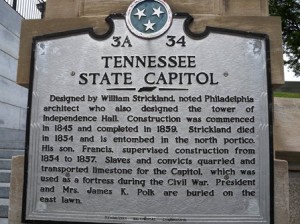 they were allowed to walk through Xray, and given directions to the elevator. “That’s not very welcoming,” I commented to the officer, noting his name on his badge and adding “Mike,” to my sentence, aiming for a friendly tone. “Why do you require photo ID before allowing people to visit their state capitol? I haven’t seen that anywhere before.” Mike shook his head in a kind of apology. “We’ve had so many threats,” he answered. “We check names against our database of people who are considered dangerous and not allowed in.” We chatted a while, discussing the fine line between “openness” and “safety” with regard to public buildings in this day and age. The Tennessee State Capitol is a treasure, to be sure,
they were allowed to walk through Xray, and given directions to the elevator. “That’s not very welcoming,” I commented to the officer, noting his name on his badge and adding “Mike,” to my sentence, aiming for a friendly tone. “Why do you require photo ID before allowing people to visit their state capitol? I haven’t seen that anywhere before.” Mike shook his head in a kind of apology. “We’ve had so many threats,” he answered. “We check names against our database of people who are considered dangerous and not allowed in.” We chatted a while, discussing the fine line between “openness” and “safety” with regard to public buildings in this day and age. The Tennessee State Capitol is a treasure, to be sure, 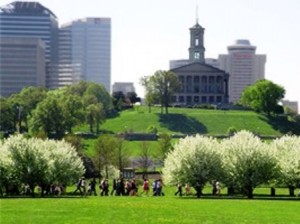 filled with historic moments and memories; it even serves as the final resting place of its architect William Strickland, who is buried in the northeast corner. Though sitting high atop a hill, the building is dwarfed today by the city that has grown up around it; skyscrapers and congested streets almost edge out the feel of history. But I’d come to see; I said goodbye to Mike and headed down the hall, my photo-pass stuck to my shirt. » read more
filled with historic moments and memories; it even serves as the final resting place of its architect William Strickland, who is buried in the northeast corner. Though sitting high atop a hill, the building is dwarfed today by the city that has grown up around it; skyscrapers and congested streets almost edge out the feel of history. But I’d come to see; I said goodbye to Mike and headed down the hall, my photo-pass stuck to my shirt. » read more
» posted on Sunday, April 21st, 2013 by Linda Lou Burton
Leave As Friends
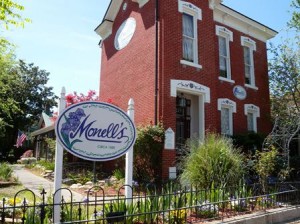 Linda Burton posting from Nashville, Tennessee – “Enter as strangers, leave as friends.” That’s what happens when you gather round the dining table and start passing the peas. And the mashed potatoes, and meatloaf, and all the other goodies that grace the table. I was sitting in Monell’s, a family style restaurant in a historic 1880’s house in Germantown, a north Nashville neighborhood. Baskets of corn muffins, pitchers of sweet tea; pass to the left, please; you can’t help it, you start to chat. “My husband died in February,” said Sandra, on my left. “My son brought me out for
Linda Burton posting from Nashville, Tennessee – “Enter as strangers, leave as friends.” That’s what happens when you gather round the dining table and start passing the peas. And the mashed potatoes, and meatloaf, and all the other goodies that grace the table. I was sitting in Monell’s, a family style restaurant in a historic 1880’s house in Germantown, a north Nashville neighborhood. Baskets of corn muffins, pitchers of sweet tea; pass to the left, please; you can’t help it, you start to chat. “My husband died in February,” said Sandra, on my left. “My son brought me out for  lunch today.” Terrance nodded, “We’re walking in the park after lunch,” he said, “I’ve lost almost a hundred pounds in the last year.” He pulled out his cellphone to show a picture of his former self; his mother and I lavished him with praise. On my right sat Allison and Matt; Matt directs a local TV show and gave me the scoop on the Nashville scene; in turn they wanted to know absolutely everything about the Journey. A month’s worth of friendliness, over chicken and dumplings; where can you find that, except when sharing a meal? No fast food hurry up, just take your time and talk. Family dining, the old-fashioned way. Monell’s was my Saturday treat; today I headed far out in the country to the
lunch today.” Terrance nodded, “We’re walking in the park after lunch,” he said, “I’ve lost almost a hundred pounds in the last year.” He pulled out his cellphone to show a picture of his former self; his mother and I lavished him with praise. On my right sat Allison and Matt; Matt directs a local TV show and gave me the scoop on the Nashville scene; in turn they wanted to know absolutely everything about the Journey. A month’s worth of friendliness, over chicken and dumplings; where can you find that, except when sharing a meal? No fast food hurry up, just take your time and talk. Family dining, the old-fashioned way. Monell’s was my Saturday treat; today I headed far out in the country to the 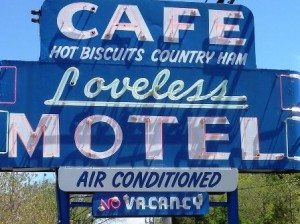 famed Loveless Café for Sunday brunch. Willard Scott claimed the Loveless has the “world’s greatest scratch biscuits” and Martha Stewart said it was “the best breakfast I ever had.” But the reality of the Loveless popularity really hit when I wound up in the unpaved parking lot on the far end of the property. Hundreds of biscuit-hungry folks were already waiting to be fed. » read more
famed Loveless Café for Sunday brunch. Willard Scott claimed the Loveless has the “world’s greatest scratch biscuits” and Martha Stewart said it was “the best breakfast I ever had.” But the reality of the Loveless popularity really hit when I wound up in the unpaved parking lot on the far end of the property. Hundreds of biscuit-hungry folks were already waiting to be fed. » read more
» posted on Friday, April 19th, 2013 by Linda Lou Burton
Visit Vanderbilt
 Linda Burton posting from Nashville, Tennessee – “Your trip to Nashville is not complete until you visit Vanderbilt.” That’s what it says in their brochure. No kidding, the loveliest bit of tourist info I have in my stack of “things to do in Nashville” is from Vanderbilt University. You expect bastions of learning to focus on enticements to attract new students, or new donors, and research institutions to tout their contributions to the world and their ranking in the research dollars they pull in every year. You expect institutions with high-profile sports programs – especially money-makers football and basketball – to brag and strut. But I’ve never yet come across an institution of learning that invites you to come to its campus simply because it offers so much for a visitor to experience. “Vanderbilt is more than a world-class university. It is a playground for the senses, open to anyone with a curious heart and mind and an appreciation for beauty and vibrancy.” That’s downright poetic! The visitor brochure I have in hand unfolds to a 9 x 24-inch display; a matte finish pleasing to the eye; photos show students in various settings: walking beneath sunlit golden trees, studying beside a peaceful fountain;
Linda Burton posting from Nashville, Tennessee – “Your trip to Nashville is not complete until you visit Vanderbilt.” That’s what it says in their brochure. No kidding, the loveliest bit of tourist info I have in my stack of “things to do in Nashville” is from Vanderbilt University. You expect bastions of learning to focus on enticements to attract new students, or new donors, and research institutions to tout their contributions to the world and their ranking in the research dollars they pull in every year. You expect institutions with high-profile sports programs – especially money-makers football and basketball – to brag and strut. But I’ve never yet come across an institution of learning that invites you to come to its campus simply because it offers so much for a visitor to experience. “Vanderbilt is more than a world-class university. It is a playground for the senses, open to anyone with a curious heart and mind and an appreciation for beauty and vibrancy.” That’s downright poetic! The visitor brochure I have in hand unfolds to a 9 x 24-inch display; a matte finish pleasing to the eye; photos show students in various settings: walking beneath sunlit golden trees, studying beside a peaceful fountain;  cheering a ball game, shopping at the bookstore, playing violin. There are pictures of a historic building, a classroom, a reception hall, the dining room. But even more critical to an actual visit is the information panel –the address and a map; the website and a phone number. It advises where to park, and which building to visit first. Go to Kirkland Hall; the university receptionist can answer questions and talk to you about touring the campus. Vanderbilt wants me to visit, I’m convinced. » read more
cheering a ball game, shopping at the bookstore, playing violin. There are pictures of a historic building, a classroom, a reception hall, the dining room. But even more critical to an actual visit is the information panel –the address and a map; the website and a phone number. It advises where to park, and which building to visit first. Go to Kirkland Hall; the university receptionist can answer questions and talk to you about touring the campus. Vanderbilt wants me to visit, I’m convinced. » read more
» posted on Wednesday, April 17th, 2013 by Linda Lou Burton
Untangling Nashville
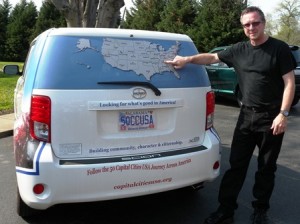 Linda Burton posting from Nashville, Tennessee – “The thing I love about Nashville is that it’s a big city that feels like a small town.” I heard that statement three times in a row today, from people of different ages in different settings. The same exact words! “A big city that feels like a small town.” I asked each one to explain what they meant. “People are friendly,” was one answer. “Everybody takes care of each other.” “It’s just a bunch of good neighborhoods.” “People here have no pretenses.” Dendy, who’s in the music business, talked about the rich and famous who call Nashville home. “They like to spend time here because they can walk around and rub elbows with everybody else with no hassle.” Martha, who travels the south in her marketing job, talked about the friendliness here. “I’d choose Nashville over any other city,” she said. “It’s pretty, and there are a million things to do. We’ve got good music and we’ve got good churches and we’ve got really good food. I always feel good when I get close to Nashville.” I interrupted Martha at that point. “I felt terror,” I threw in. “The traffic!” “Well,
Linda Burton posting from Nashville, Tennessee – “The thing I love about Nashville is that it’s a big city that feels like a small town.” I heard that statement three times in a row today, from people of different ages in different settings. The same exact words! “A big city that feels like a small town.” I asked each one to explain what they meant. “People are friendly,” was one answer. “Everybody takes care of each other.” “It’s just a bunch of good neighborhoods.” “People here have no pretenses.” Dendy, who’s in the music business, talked about the rich and famous who call Nashville home. “They like to spend time here because they can walk around and rub elbows with everybody else with no hassle.” Martha, who travels the south in her marketing job, talked about the friendliness here. “I’d choose Nashville over any other city,” she said. “It’s pretty, and there are a million things to do. We’ve got good music and we’ve got good churches and we’ve got really good food. I always feel good when I get close to Nashville.” I interrupted Martha at that point. “I felt terror,” I threw in. “The traffic!” “Well,  yes, there is a lot of traffic,” she conceded, “and the streets can be confusing until you learn your way around.” I’ll say! Street names change at almost every turn; this road goes there and that road turns this way. There are freeways and parkways and boulevards and pikes. A lot of pikes, for a lot of cars, for a lot of people. Nashville’s population is 601,222 (US 2010 Census) and it’s the 6th largest capital city – just a tad smaller than Boston and a tad larger than Denver. My challenge is to untangle the mystery: why does big-city Nashville feel so small-town sweet? » read more
yes, there is a lot of traffic,” she conceded, “and the streets can be confusing until you learn your way around.” I’ll say! Street names change at almost every turn; this road goes there and that road turns this way. There are freeways and parkways and boulevards and pikes. A lot of pikes, for a lot of cars, for a lot of people. Nashville’s population is 601,222 (US 2010 Census) and it’s the 6th largest capital city – just a tad smaller than Boston and a tad larger than Denver. My challenge is to untangle the mystery: why does big-city Nashville feel so small-town sweet? » read more
» posted on Monday, April 15th, 2013 by Linda Lou Burton
Stockton’s Valley
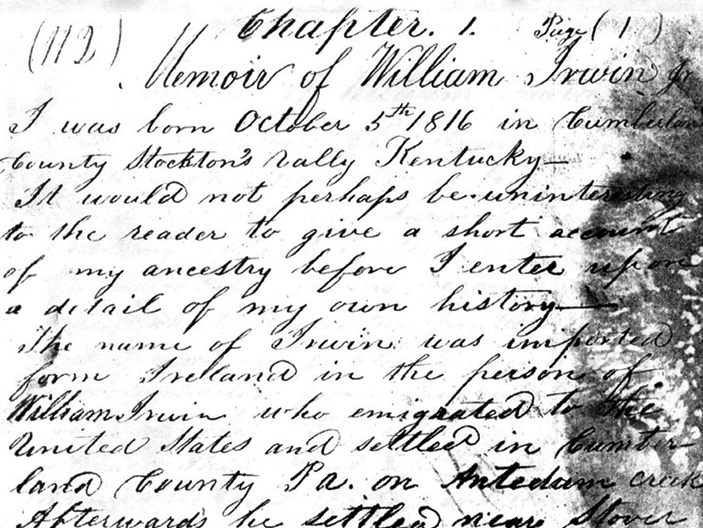 Linda Burton posting from Nashville, Tennessee – I was born October 5 1816 in Cumberland County Stockton’s Valley Kentucky. That is the beginning line in the Journal of William Irwin Jr, my 3rd-great-grandfather. My path today, as I headed south from Frankfort to Nashville, would lead me through Stockton’s Valley. For weeks I’ve been following the trail of Daniel Boone and the pioneers who moved westward into Kentucky; now this is my day to get personal with history. William is my relative and my pioneer; and best of all William kept a Journal; he left behind a written picture of his life and times. My brother discovered William’s Journal just a few years back; the original is in possession of a distant cousin in Oregon, who kindly sent us copies. William died of cholera in 1849 as he and his family headed for the new state of Texas; he is buried by the trail in Arkansas, alongside his father William, and three of his children, a heartwrenching story as are so many stories of this
Linda Burton posting from Nashville, Tennessee – I was born October 5 1816 in Cumberland County Stockton’s Valley Kentucky. That is the beginning line in the Journal of William Irwin Jr, my 3rd-great-grandfather. My path today, as I headed south from Frankfort to Nashville, would lead me through Stockton’s Valley. For weeks I’ve been following the trail of Daniel Boone and the pioneers who moved westward into Kentucky; now this is my day to get personal with history. William is my relative and my pioneer; and best of all William kept a Journal; he left behind a written picture of his life and times. My brother discovered William’s Journal just a few years back; the original is in possession of a distant cousin in Oregon, who kindly sent us copies. William died of cholera in 1849 as he and his family headed for the new state of Texas; he is buried by the trail in Arkansas, alongside his father William, and three of his children, a heartwrenching story as are so many stories of this 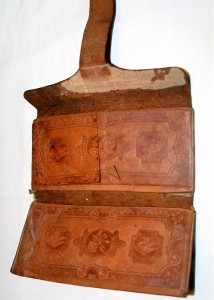 country’s settlement. The Journal was preserved in a handsome leather pouch; an amazing tale for us to read today. The first page continues: The name of Irwin was imported from Ireland in the person of William Irwin who emigrated to the United States and settled in Cumberland County Pa on Antedum Creek. He had three sons, James, Robert & John. The latter of whom was my grandfather who married a woman of Welsh descent by the name of Elizabeth Cunningham.…grandfather… was a soldier in the revolutionary war….Grandfather had three sons…my father William, Francis, and John. Francis married but had no heirs and died in Cotton Gin Miss. John settled in Cumberland Cty Ky and had a large family of children.
country’s settlement. The Journal was preserved in a handsome leather pouch; an amazing tale for us to read today. The first page continues: The name of Irwin was imported from Ireland in the person of William Irwin who emigrated to the United States and settled in Cumberland County Pa on Antedum Creek. He had three sons, James, Robert & John. The latter of whom was my grandfather who married a woman of Welsh descent by the name of Elizabeth Cunningham.…grandfather… was a soldier in the revolutionary war….Grandfather had three sons…my father William, Francis, and John. Francis married but had no heirs and died in Cotton Gin Miss. John settled in Cumberland Cty Ky and had a large family of children.
It is John’s grave I’m looking for today; the target is Albany Cemetery. » read more
